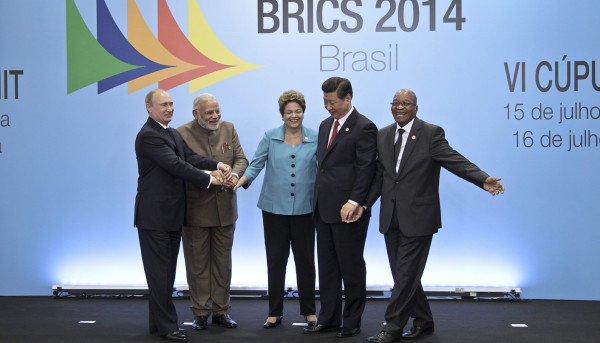On February 20,Russia officially ratified the $100 billion BRICS Development Bank agreement. The formation of the BRICS (Brazil, Russia, India, China, South Africa) Development Bank was agreed on July 15, 2014 and has since caused widespread speculation on what this means for the future of the world economy.
Speaking to a group of reporters, Russian President Vladimir Putin declared the BRICS Bank as “one of the major multilateral development finance institutions in this world.” The other major multilateral development financial institutions being the World Bank, and the International Monetary Fund (IMF).
The stated goal of the BRICS Bank is to provide money for infrastructure and development projects in and around the BRICS countries. This will consist of specializing in counties on the African, Asian and South American continents. It will also run as an alternative to the largely U.S. influenced IMF and World Bank.
There have been many criticisms of the current lending practices by the IMF and World Bank— failure rate for its projects in the poorest countries was 65%-70% and 55%-60% for all developing societies.
Although their focus is partially different from the stated goals of the IMF and World Bank, the BRICS Bank will follow similar lending practices. Contrary to the IMF and World Bank, the BRICS Bank will operate in an equal manner between the participating countries, in which each country has one vote, and none of the countries have veto power.
The governance will consist of three tiers with a Board of Governors, Board of Directors and a President. The positions will rotate between the countries. Early reports are pointing to Russian Finance Minister Anton Siluanov becoming the Bank’s first Chairman of the Board of Directors.
Largely centered around facilitating fair dealings and equivalent authority, the bank will be headquartered in Shanghai, with a reserve currency of $100 billion.
The biggest question is, what will come of this new development bank?
There have been many criticisms of the current lending practices by the IMF and World Bank. A repeated criticism is their high failure rates. Assessments from the World Bank showed the failure rate for its projects in the poorest countries was 65%-70% and 55%-60% for all developing societies. While international lending has proven to be difficult, what can we expect from the BRICS in terms of learning from the past mistakes of the IMF and World Bank?
Many of these difficulties will be tied to globalization and the effects it has had on the systems currently set in place. With a bank specifically set up by developing countries to help facilitate growth in developing countries, I would suspect there to be more genuine lending practices.
Another question that needs to be asked is, “what impact will this have on the global geopolitics, specifically in the discussion of reserve currency?” We have already seen some of the BRICS countries, namely Russia and China move away from dealing in U.S. dollars, instead choosing to deal in the local currencies.
A further inspection of the relationship between China and Russia, who are seen as the leaders of the BRICS, will show their continued geopolitical partnership. In 2014 trade between the two countries amounted to over $90 billion, and expectations are for that number to rise to $200 billion within the next five years. Much of their dealings are in the aviation, space and nuclear energy sectors.
Most recently in response to the opprobrium credit rating handed to them by the major credit rating agencies Moody’s and the S&P, Russia with the cooperation from China decided to create their own joint credit rating agency. Much has been made of these ratings, with Russia citing political discrepancies being the cause for such low ratings.
These geopolitical dealings will help shape the future of the global economic landscape. The shared authority within the bank will aid in promoting sustained global equality, while also helping to develop emerging markets to adequate levels of prosperity. Since the main goal of the BRICS Development Bank is to support and fund emerging markets’ need for infrastructure they can assist developing countries gain the ability to become self sustainable.
The BRICS countries account for 41.4 percent of the world’s population, and more than 25 percent of the world’s GDP. By forming this development bank, they effectively demonstrated their want for an adequate say in the global economy in accord with their aggregate size. By acknowledging this, the BRICS will have a larger say in world issues and will more accurately depict the worlds view on global issues.
The BRICS Development Bank will allow emerging markets to successfully tap into the resources that will provide the facilitation of their growth in the coming decades. This not only creates more parity in the world economy, but also cultivates a growing sense of change that is needed in global economics.
-Mark Siatta
